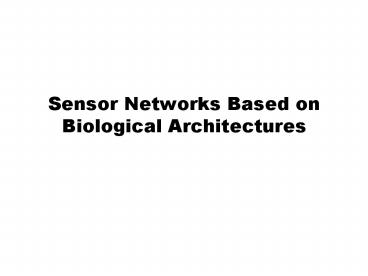Sensor Networks Based on Biological Architectures PowerPoint PPT Presentation
1 / 25
Title: Sensor Networks Based on Biological Architectures
1
Sensor Networks Based onBiological Architectures
2
Scenarios
Atmospheric Research
Planetary Exploration
Industrial Monitoring
3
Assumptions
- Autonomous sensor network
- Self-deploying, self-monitoring, self-repairing
- Variety of functional devices
- Carriers, data collectors and transmitters,
sensors - Variety of sensor devices
- Position sensors, cameras, temperature sensors,
spectrometers, etc.
4
Properties of Biological Architectures
- Self-Organization
- Fault-tolerance Survivability
- Evolution
5
Mechanisms of Biological Architectures
- Migration
- Birth/death Renewal
- Diversity in Reproduction
- Pheromone Communication
- Food
6
Example 21st Century Planetary Exploration
The Mars Microprobe Project will demonstrate key
technologies for 21st century "network" missions,
in which multiple microprobes or landers,
released from a single spacecraft, will provide
comprehensive studies of dynamic, complex
phenomena, such as climate systems and seismic
activity. -NASA
7
Goals
- Geographical mapping
- Exploration and mapping of topology, surface
conditions, density, etc. - Distributed sample/data collection
- Collecting soil samples, images, atmospheric
measurements, etc. - Finding target object types
- Detecting water, minerals, geothermal activity,
life, etc. - Performing experiments
8
Types of Sensor Agents
- Oribiting station
- Satellite orbiting station to accept commands
from Earth and relay data back to Earth. - Base station(s)
- Ground stations responsible for accepting and
relaying data to orbiting station. - Carriers
- Long-range vehicles which carry smaller agents.
- Mappers
- Rovers responsible for mapping the geographical
topography - Local Positioning System (LPS) transmitters
- Ad-hoc local transmitters (arranged in a
triangular configuration)used to construct
accurate positional information for other agents.
- Mobile lab rovers
- Rovers which conduct experiments.
- Power sources
- Agents which generate/provide power (solar,
geothermal, battery, etc.) - Note that one physical device may be
multi-functional, I.e., one physical device may
be capable of performing more than one of the
functions above.
9
Communication
- Ad-hoc networking. Ability to relay information
in an ad-hoc network, with dynamic upload
stations and minimal centralized control. - Location awareness. Agents need to be aware of
their positions relative to other agents, either
through adjacent signal detection, or through a
local positioning system (LPS).
10
Coordination
- Coordination of diverse elements. System must be
able to coordinate agents with diverse functions
(as listed in Types of Sensor Agents). - Dynamic evolution of behavior. Multi-functional
devices may dynamically change behavior, I.e.
transform from a mapping agent to a lab agent
dynamically. - Staggered lifetimes. Different groups of agents
may be activated at different times. One group's
completion may trigger another group's
activitation. Lifetimes of different groups may
also be staggered to prolong mission life. - Predictive coordination. System must adaptively
use algorithms to coordinate multiple agents to
meet conditions on-hand. For example, multiple
agents may self-coordinate to explore a cave by
forming an arm of the ad-hoc network into the
cave. - Environmental learning. System must collectively
learn to avoid hazards, navigate the topography,
zone in on interesting areas, etc.
11
Control
- Integrated remote/autonomous control. Since
sensor networks may be deployed in locations not
permitting real-time control, such systems must
support autonomous control guided by high-level
remote control commands. - Safe bootstrapping. System must have capability
to be reset to a safe operating state. - Dynamic reconfiguration. System must have
capability to be dynamically reconfigured by
downloading new software.
12
Fault Tolerance/Survivability
- Minimal centralized control. Avoid centralized
control of groups of agents to avoid a single
point of failure. - Power management. Methods to conserve power, and
to efficiently distribute power, may prove
essential. - Fault recovery. The ability to recover from
unseen obstacles, faults, accidents, etc, using
techniques such as physical recovery, control
reset, etc. Backup procedures when primary
procedures fail are also essential.
13
Security
- Communications encryption. May want to encrypt
communication if sensor network is deployed in
enemy territory. - Timed expiration. Software or hardware needs to
self-destruct to avoid being stolen by enemies.
14
Example Scenario
- Orbiting station
- Base station(s)
- Carriers
- Mappers
- Local Positioning System (LPS) transmitters
- Mobile lab rovers
- Power sources
15
1. Orbiters deploy base stations
16
2. Base stations deploy carriers
17
3. Carriers deploy mappers and LPS transmitters
18
4. Mappers establish topography and areas of
interest
- Mappers coordinate through pheromone mechanisms
and LPS coordinates - Focus in on interesting areas
- Avoid hazards
19
5. Mappers return to carrier
20
6. Mobile lab rovers are deployed towards
interesting areas
21
7. Mobile lab rovers conduct experiments
22
8. Mobile lab rovers return to carrier
23
9. Carrier returns to base station, coordinates
with other carriers
24
10. Carrier pursues further sub-missions.
25
Important Properties
- Strength in Numbers Deploy a large number of
miniature devices - Fault tolerant
- More cost effective if devices are manufactured
in large quantities - Evolution
- Entire system evolves to adapt to conditions
- Devices change functionality
- Emergent Behavior
- Desired goal is achieved through cooperation of
large number of autonomous devices which
communicate among themselves

